“There Are No True Himbas Anymore”: Exploring the Dynamics of the Himba Culture and Land Use in the Face of Change in Kunene Region, Namibia
Abstract
1. Introduction
1.1. Background
1.2. The Concept of Culture and Cultural Transformations
2. Materials and Methods
2.1. Study Sites
2.2. Research Design
2.3. Participant Selection
2.4. Data Collection
2.5. Instruments
- Is the Himba culture changing, and is this change good or bad?
- What aspects of culture have changed, and what has contributed to this cultural shift?
- What is threatening the Himba cultural identity?
- Did environmental issues such as drought affect your cultural practices?
- What is a true Himba?
- Is there a change in land use?
- What is your perception of nature, and has the natural environment changed?
- What is the state of the natural environment?
2.6. Data Analysis
3. Results
3.1. Perceived Changes in the Himba Culture: Has the Himba Culture Changed, and Is This Change Good or Bad?
3.2. What Aspects of the Himba Culture Have Changed?
3.2.1. The Dress Code Has Changed
“Everything has changed now; for example, anklets and bracelets for women are now made from rubber because they can stretch well and easily be removed. Moreover, many Himba women are now braiding their hair artificially, wearing modern dresses and covering up. It seems there is a feeling of nakedness that comes with development; we start feeling that it is not normal, and the new life is very necessary.”F7
“We used to dress up beautifully in full tradition. There were different dress codes for different stages and genders.”M17
“The culture has changed. We used to wear traditional clothes that we no longer wear. For example, we only used to put on a small leather to cover our lower bodies, but now that has changed, even the design of our skirt has changed. Our dress code was different according to different age groups. For example, a girl who has started her period should wear a different attire from those who have not yet menstruated.”F1
“Even women who wears traditional Himba attires have modified them to cover themselves slightly more. Now we have modified our traditional clothes by making the skirts longer and adding extra decorations. Our women never had bare arms or legs; they were covered with bracelets, and only orphans had bare arms to show that they had lost their fathers. The older women wore bracelets covering their whole arms. Our women looked beautiful then, but now they have started wearing modern clothes.”F3.
3.2.2. The Use of Modern Tools
“We used to eat on traditional wooden plates and used our hands to eat. Now we are just using modern bowls and plates to eat in. Eating with hands is now considered dirty and unhealthy. So it is no longer okay.”F2
“In the past, we used stones as pillows, but now we are using modern soft pillows. Even the cattle herders back then would use animal leather as blankets, which gave them sores, but at least now they are using modern matrasses.”M11
3.2.3. The New Generation Now Goes to School
“In our time, we did not even see papers as we were growing up. Education is very important, and I tell all the young ones to go to school so they can learn.”H49
“The young generation is now also just going to school instead of going to look after cattle. When they return from school, they call us stupid and uneducated.”M5
3.2.4. The Diet Has Changed
“We only used to eat meat and sour milk, and now we eat porridge. In this way, the culture has changed.”M5
“A long time ago, we collected and ate wild honey and ground tubers and collected them in the wild easily. However, now we cannot eat some of these wild foods because people will laugh at us and ask, why not eat apples instead?”M7
“The culture has changed because, in the past, we ate a type of grass called Ombuma (grass), but now we are eating rice and other modern food. This way, the culture has changed because we no longer consume Ombuma.”M13
“Things have changed because wild foods have become scarce (like Omambibo), and even if you see them, you will start thinking about carrots and potatoes.”M14
3.2.5. Their Hairstyles Have Changed
“Small girls used to have a different hairstyle from elders; their hair used to be plaited with two cornrows facing in front called ‘ondato,’ and they change this hairstyle as they reach puberty. Men also had different looks at different stages, for instance, when transitioning from small boys to young men and getting married. This depended on their totems too, especially with the hairstyle, but it typically has one cornrow facing at the back, at the middle of the head, and cutting all side hair off.”F7
“Back then, married men had a hairstyle that looked like a helmet (See Figure 5). However, most married men no longer carry that hairstyle, and they look funny now. There is no distinction between those who are married.”F3
“Young people do not care anymore; a young man can get married yet no sign, they are cutting their hair with no limits, they do not respect their culture anymore. As much as things seem to be made easier, the change has consequences.”M18
3.2.6. Some Traditional Rituals Have Ceased
“We used to practice a certain ritual for girls entering puberty, where younger girls used to go behind the house with their mates, break all the neckwear they had on, and bring the remains back home. We would then slaughter a cow and have a celebration to signify their next stage when they start their period, but now it does not happen anymore.”F3
“Many changes come with marriage. In the past, married men used to cut their beards for the first time, and one was regarded as ready to get married depending on the length of their beard. This is no longer observed. It was also during this stage that the married man changes his hairstyle into ‘okandumbo’ style and remove their cornrows by cutting off half of the cornrow from the back, opening the hair and putting tree bark chips with red ochre to strengthen it, close it and tie it tightly pointing upward. This is only to be removed when one is widowed or divorced.”M17
“This is a special man amongst us all. He is the only one who can permit anyone to enter the Ehomba mountain by making a fire and making you stand on a stone. He will then summon the ancestors that you want to go to the mountain. Even when one is not feeling okay, like having Malaria, he can inform the ancestors to heal you. The man usually has a woven basket with some leaves in it. However, now it only happens once or twice a year. The man has authority because it was passed on to him by his father.”M7
“My powers are no longer strong because only a few people now come to me for healing. They are now going to hospitals and churches, etc.”M15
“It negatively affected us because our big men (witch doctors) need animals to sacrifice for clarity. Now, we no longer have livestock to sacrifice to our ancestors.”M4
3.2.7. There Is a Sense of Increased Promiscuity
“When I was young, I used to look after goats, and I would strictly sleep at home because I was still too young to start sleeping around. Now young girls already have more than two kids at a very young age, when they are not married.”F2
“For now, in boarding schools, children are just falling pregnant and sleeping with each other in the hostels; the family structure is now broken. The hostel situation is worse there, the young men bringing their girlfriends into the hostel.”M17
“In the past, though children were given into marriage at a young age, the men were not allowed to be seen with their chosen wives anytime, or a woman visiting the man’s house; otherwise, the man would pay. They only took their wives when they had reached reproduction age. Moreover, if your chosen bride gets pregnant by someone else, before or after marriage, the child is considered yours because she is your wife, so children were still raised by both parents even if they are not biologically yours.”M19
3.2.8. Changes in Marriage Practices: Choice of a Partner
“Previously, men had no say in choosing a wife at any stage of their lives. Similarly, women could not say no or yes when their parents gave them into marriage. Parents chose their preferred wife for their son. This only happens when a man is really grown, approximately above 30 years. Usually, the length of the beard determines if one was old enough to get a wife because a man was not allowed to cut his beard until he gets married. This system was biased because some men genetically develop beards very late or with slow growth in length. Now, young men and women can make their own decisions about marital partners on their own timing. People are walking freely with their fiancées in the village now with no penalties, visiting each other before marriage, and if any of them bears a child outside, the child can come home or to the grandparents’ house. After parents notice that your beard is long enough, it remains their secret that you are ready for marriage. So they find for their son a young bride, from 5 years old, and a ritual is performed as an engagement. From there, you start raising your wife, taking care of her, and gifting her until she reaches the teenage stage to take her home. The reason for a young wife is to take care of the husband and give birth until the man is old. In the process of the engagement, if this young man happens to impregnate another lady, it is regarded as an abomination, and he cannot tell his parents. This was unacceptable, and this child will not be regarded as his own.”M7
“In the past, our parents advised us to marry into families that are maybe friends with our fathers. This was good because the two families could work well together compared to marrying someone from a family you do not know. This was good because divorce rates were very much lower. The old marriages were good because people were forced to remain married by their parents, and they had to make it work. Now, there is no order or customary law to override the government laws on marriage, so anyone can divorce as they like.”M5
“It was very different in the past; if a lady gets a baby while unmarried, that child will automatically belong to her father. If a man gets children with someone who is not their wife, then the children will not be regarded as his. They will belong to the woman’s father. That was much better compared to now. The burden is too much as young men are just dumping their many children to their mothers. Nevertheless, now it is allowed. For me, the old practice was perfectly fine. It does not look good now. I have sons who live far away from home; some are now educated. They simply dump their children here and leave. I have to look after their children, my grandchildren. Now I am suffering here alone because my children go to town and only return to bring me more babies.”F1
“Nowadays, marriages are not okay because women may leave their husbands lying that they are just going somewhere to visit, and they take forever. In fact, when they return, some even come back re-married by someone else because now they are not afraid of their fathers. The new marriage arrangements are not good because people are no longer afraid to marry and divorce each other out there on the streets.”M9
“In my culture, in the past, as a man, I could not choose who should be my wife. It was the responsibility of the parents to choose spouses for their children. Parents decide whom their children should marry. But now, some women, if you force them to marry a man they do not want to marry, they will tell you they will report it to the police. Nowadays, young people choose their own spouses, and things have become chaotic now, and so many divorces compared to how things were in the past.”M6
“The reason why parents chose spouses for their children was because they knew better. Now that young people are choosing for themselves, there are more divorces. Long time, our parents would advise us to marry a lady related to us. However, in the present, men and women have the right to choose who to marry. It is not good because sometimes the ladies we want to marry may be crazy.”F6
“Long time ago, even if you beat your wife, and she goes to report to her parents, she will just be told to return to her husband even if her eye was beaten out.”F9
“Previously, men did not have a say in choosing a wife at any stage of their lives. Similarly, women cannot say yes or no when they are chosen. Marriage was all arranged by the parents. They choose a preferred wife for their sons. This only happens when the man is really grown, approximately about 30 years old.”M16
3.2.9. Gender Roles Have Changed
“In the past, men were not allowed to cook food, even meat; only women could cook. However, men can now cook and do all kinds of household chores.”M6
“In our culture, cooking was a curse if you had a wife.”M16
“Back then, women had no right to say or do anything, even to discipline or “beat” their own child. However, now they have all rights just like men.”M5
“Back in the day, men were not allowed to sit with women; even though she was your wife, you could not sit with her in public. In the past, men were also not allowed to make gardens, only women, though the first harvest from the garden was only eaten by men before the women. However, now all that has changed, men can sit together with women and men can now make gardens and cook.”M20
3.2.10. Some Cultural Aspects Are Now Seen as Depicting a Sense of Shame
“Yes, the culture has changed in some ways, for example, now we wear modern expensive clothes from the shops. When we go to bigger towns like Ongwediva wearing traditional clothes, people laugh at us, saying we are crazy. If one visits a big town wearing traditional clothes, one will be shamed and laughed at.”M16
“In the past, we had a ritual to remove the four bottom incisor teeth for fashion. Nowadays, children do not want their front teeth removed. The removal of teeth in both genders was to make them look beautiful at the age of 16 and above. We do not use it anymore because it is no longer a sign of beauty but shame. It can affect speech, and young people shy away from it. If you have your teeth removed, you will be laughed at and shamed. For some of us, who had our teeth removed, we now have to buy new teeth because we feel we do not qualify to be in a city like Windhoek without proper teeth. In the past, one cannot even be given Omaere if you didn’t have the teeth removed. But now the new generations are refusing to have them removed because they feel they will not be able to speak English. In fact, some are trying to get them replaced. They fear they will not get partners that are not coming from their tribe. Back then, we were lied to that if we do not remove our front teeth, the teeth would eat our droppings when we went to the toilet. However, young people are now refusing to remove their teeth. All the young ones now have all their teeth intact. When we go to some towns, they will make fun of us, like telling us to eat apples with our front jaws while there are no teeth. It negatively affects our lives because we now need a lot of money to replace them.”M17
“Long time ago, we used to collect and eat wild honey and ground tubers and collected them in the wild easily. However, now we cannot eat some of these wild foods because people will laugh at us and ask, why not eat apples instead?”M13
“A long time ago, the only woman who could dress the way I am dressing right now was one who had lost their father. If you still have your father, you are supposed to dress well. My father is not even proud of the way I am currently dressed. However, when I wear my bracelets and anklets and go to a town like Ongwediva, people there will laugh at me.”F5
“Yes, our children are not wearing traditional clothes when going to school. This is because others will laugh at them and bully them. When they return home, they force their parents to buy them modern clothes so they look like others.”M3
“A certain teacher at Ehomba school asked about the Zemba tribe scholars whether they are “human” or “Zemba” or are they even humans. So things like discrimination because of our culture are also affecting us.”F1
3.2.11. A Sense of Individualism and Self-Determination
“In the past, one could choose from the relative’s cattle herd, whichever calf they wanted to make their leather from, and it would be done for you. Families were stronger back then. Now, if you do not have your own resources, you will suffer alone. Everyone is concentrating on their own children. Cattle is now expensive, but you can buy cheaper clothing to cover up. And as years goes by, the spirit of change gets stronger on every tribe worldwide, hence the shift.”M17
3.2.12. Cultural Change Has Brought a Sense of Loss
“Things have changed because wild foods have become scarce (like Omambibo), and even if you see them, you will start thinking about carrots and potatoes. They are very healthy, but we seem to be losing them. We have lost out on some really healthy food options because of the introduction of modern food.”M13
“Even for me as a man, I was not supposed to be wearing these clothes but rather leather. I am now wearing a cap. We are lost.”M2
“A long time ago, women had nice scents because of certain herbs they used, and they do not use those perfumes anymore. Now, they do not smell as nice. The nice scent was a nice treat for men visiting their women.”M16
3.3. Factors Threatening and Influencing the Himba Culture
“The culture is changing. The culture is threatened by things such as education. In the coming years, the Himba culture will die, and we will only see it in museums that this is how the Himba people used to wear and live. I think when our current old people die, that will be the end of the Himba culture.”M6
3.3.1. The Influence of Education on the Himba Culture
“When development reached us, we have sent some of our children to schools, and they came back with fashion, and influenced us to wear more like town people, use perfumes, braid our hair etc. For instance, when parents have to go for meetings or graduations, they will suggest or even impose some special attire for their parents to wear on these occasions.”M19
“If people become educated, they will no longer return to their traditional way of life. Education will keep changing them and kill all the traditions in them. For example, when children attend school in their traditional attire, others will laugh at them, so they are forced to wear modern clothes.”M6
“My child came from school and asked me, as his father, to get him modern clothes.”M2
“Certain families of Himbas do not eat certain food or animals or parts of an animal as part of the family tradition and ritual. For example, some families do not consume meat from cows without horns. This is because it will bring bad luck to the family. However, once the children go to school in towns, they eat everything, even cows without horns. Then culture is lost in the process.”M4
3.3.2. The Influence of Religion on the Himba Culture
“People who attend church are not allowed to wear their traditional clothes.”M6
“Evangelism has an impact on our tradition. After many sermons we realized that we need to leave behind some practices, you need to go to church, wear church clothing etc.”M19
“We lived in our own little world. Our faith was merely in our ancestors. We believed they protect us, they bring rain, they heal us, they feed us, they multiply our livestock, they bless us and everything. As long as we had our livestock, life was sorted. We also used traditional remedies to heal the sick, using spells and plant-based materials from spiritual trees such as Mopane, Grewia species and Terminalia to call on the spirits for healing. We have been hearing the name of God for a long time. We knew there was ‘Mukuru’ controlling the universe, but we lacked the truth, direction, and we were even reluctant to change for anything. Our tradition was so strong back then that we couldn’t be really moved by other beliefs, but now we all know that God has just been the one protecting us all along. We are now stuck with a mixed culture, the new realistic faith with understanding, and the old belief of ancestors.”M19
“We did not believe we could be more than just farmers or have other significance in the society apart from being a family head as men. The fact that people didn’t even have a voice in making future plans, it was all arranged by your parents wasn’t fair. Currently, there are more rights, choices to make, and it is up to you what you would like to believe in. This might not be the best solution for our traditional implications, but it is advantageous because at times it feels you are not bound to tight laws and beliefs you are not comfortable with.”M16
3.3.3. The Impacts of Drought on Himba Culture
“We had many cattle and lots of meat and milk. We lost the cattle and started making gardens. Livestock was the main livelihood, but now we had to learn to do other things for survival. We had so much milk when I was young that even our chicken drank milk instead of water. Then we had a drought and lost the cattle, and we had to grow more Mahangu and buy maize meal. Now we cannot eat just meat without porridge.”M7
3.3.4. The Influence of Modernization on the Himba Culture
3.3.5. The Influence of Government Laws on Himba Cultural Practices
“Some of our cultural practices are threatened or abandoned because they do not agree with the laws of our government. For example, getting married to minors was part of our culture. Child marriages were common, but now that is illegal. The girls were given into marriage when they are very young, and their husbands start sleeping with them at around 12 to 14 years, taking up the roles of motherhood at a young age.”M19
“Back then, if a man grew older without a woman, the father would look for him, a wife, even a baby, but now, according to the government law, we are not allowed to do so, which is affecting us. Because one is given a young child as a wife, they can just wait for the young girls to grow up to marry them while concentrating on looking after their cattle; now we struggle to find the right partners.”M18
“In our culture, a child has no rights; only the parents can decide for them. Now the government says 18 years is an adult, and they can make their own decisions.”F7
“When, for example, one gets five daughters or sons, according to the law, all these children must go to school. Moreover, when sent to school, they are forced to wear modern clothing and no longer want to return to poorly built houses. Instead, they prefer to move to town for a holiday until we eventually lose our children.”M3
“In the past, our animals were allowed to graze anywhere, but now some areas are prohibited for grazing. Only for some months can we use the protected lands for grazing. The government law introduces this.”M17
3.4. Participant Observations
3.4.1. Desires for Modern Items among Young People
3.4.2. Cash Has Become a Very Important Aspect of the Himba People
3.4.3. Internal Conflicts
“In this community, if you start a garden or project and they see that you are succeeding, they will start complaining that the land you have taken is for everyone, trying to stop you. It is hard because people are jealous of each other.”H11
“The headmen are not cooperative and do not work in the interest of the people.”H18
3.4.4. Some Himba People Are Open to New Developments and Ideas
3.5. Are There Still True Himbas Today?
“There are no “True” Himbas anymore! We do not even dress like true Himbas anymore.”M2
“Now, the Himba are just in-between; they are neither fully modern nor fully traditional. They are caught up between tradition and modernity. It is as though the Himba now live on the fringes of two cultures. Most young people are not wearing traditional clothes anymore. Even my wife used to wear traditional, but not anymore. The culture is changing daily.”M17
3.6. Perception of Nature and Change in the Environmental Infrastructure
3.7. Land Use Change and Cultural Shifts
4. Discussion
The Ovambo tribe, before they embraced Christianity, had a physical appearance that closely resembled the present-day Himba tribes. Both men and women would typically wear animal skins, and unmarried women would also wear elaborate ostrich shell belts called “oshindjendje.” These belts had long-scallope designs and were often decorated with shells and ivory bone buttons known as “ekipa.” Ovambo women styled their hair in intricate designs using a mixture of fats and dung to hold it in place. Like the Himba people today, they applied red ochre and fat to their skin for protection against the elements. However, with the emergence of Christianity, these traditional practices gradually faded away. The use of soap for washing became more common, and European clothing replaced traditional attire. Consequently, many contemporary Ovambo individuals are unaware of their ancestors’ physical features and resemblance to the Himba population. Interestingly enough, the “traditional” dresses worn by Oshiwambo women today actually have Finnish origins.
5. Conclusions
Funding
Institutional Review Board Statement
Informed Consent Statement
Data Availability Statement
Acknowledgments
Conflicts of Interest
References
- Kelles-Viitanen, A. Custodians of Culture and Biodiversity and Opportunities: Indigenous Peoples Take Charge of Their Challenges and Opportunities; IFAD: Rome, Italy, 2020; pp. 1–58. [Google Scholar]
- Jacobsohn, M. Negotiating Meaning and Change in Space and Material Culture: An Ethno-Archaeological Study Among Semi-Nomadic Himba and Herero Herders in North-Western Namibia. Ph.D. Thesis, University of Cape Town, Cape Town, South Africa, 1995. [Google Scholar]
- Zhang, J. Educational diversity and ethnic cultural heritage in the process of globalization. Int. J. Anthropol. Ethnol. 2019, 3, 7. [Google Scholar] [CrossRef]
- Bollig, M. Risk and risk minimisation among Himba Pastoralists in Northwestern Namibia. Nomad People 1997, 1, 66–89. [Google Scholar]
- Cameron, A.S. The Influence of Media on Himba Conceptions of Dress, Ancestral and Cattle Worship, and the Implications for Culture Change. Master’s Thesis, Brigham Young University, Provo, UT, USA, 2013. Available online: https://scholarsarchive.byu.edu/etd (accessed on 24 July 2023).
- Bollig, M. Shaping the African Savannah; Cambridge University Press: Cambridge, UK, 2020. [Google Scholar] [CrossRef]
- Kwon, J.Y.; Wormley, A.S.; Varnum, M.E.W. Changing cultures, changing brains: A framework for integrating cultural neuroscience and cultural change research. Biol. Psychol. 2021, 162, 108087. [Google Scholar] [CrossRef] [PubMed]
- Simonsen, S.H. Turning Strain into Strength: Developing Intercultural Resilience in times of Cultural Adversity. Master’s Thesis, Master in Intercultural Communication. University of Lugano, Lugano, Switzerland, 2007. [Google Scholar]
- Thiele, L.P. Sustainability (Key Concepts), 2nd ed.; Polity Press: Cambridge, UK, 2016. [Google Scholar]
- Holtorf, C. Embracing change: How cultural resilience is increased through cultural heritage. World Archaeol. 2018, 50, 639–650. [Google Scholar] [CrossRef]
- Meguro, T. The unchanged and unrepresented culture of respect in Maasai society. Afr. Study Monogr. 2019, 40, 93–108. [Google Scholar]
- Bollig, M. The colonial encapsulation of the north-western Namibian pastoral economy. Africa 1998, 68, 506–536. [Google Scholar] [CrossRef]
- Bollig, M. Towards an Arid Eden? Boundary-making, governance and benefitsharing and the political ecology of the new commons of Kunene region, Northern Namibia. Int. J. Commons 2016, 10, 771–799. [Google Scholar] [CrossRef]
- Bollig, M.; Gewald, J.-B. People, Cattle and Land: Transformations of a Pastoral Society: An introduction. In People, Cattle and Land: Transformations of a Pastoral Society in Southwestern Africa; Bollig, M., Gewald, J.-B., Eds.; Köppe: Köln, Germany, 2000; pp. 3–52. [Google Scholar]
- Harring, S.L. ‘God Gave Us This Land’: The OvaHimba, the Proposed Epupa Dam, the Independent Namibian State, and Law and Development in Africa. Geo. Int’l. Envtl. L. Rev. 2001, 14, 35–106. [Google Scholar]
- Crandall, D. The Place of Stunted Ironwood Trees: A Year in the Lives of the Cattle-Herding Himba of Namibia; Continuum: Farmington Hills, MI, USA, 2000. [Google Scholar]
- Brasche, I. Otse mbaka (This is Who We Are): Cultural Loss, Change and Recuperation in Ovamboland. Ph.D. Thesis, University of Technology, Sydney, Australia, 2003. [Google Scholar]
- Kotowicz, M.A. Maasai Identity in the 21st Century Recommended Citation. Master’s Thesis, University of Wisconsin-Milwaukee, Milwaukee, Milwaukee, WI, USA, 2013. Available online: https://dc.uwm.edu/etd/715 (accessed on 5 August 2023).
- Jahoda, G. Critical reflections on some recent definitions of ‘culture’. Cult. Psychol. 2012, 18, 289–303. [Google Scholar] [CrossRef]
- Creswell, J. Qualitative Inquiry and Research Design, 3rd ed.; Sage Publications: London, UK, 2007. [Google Scholar]
- Palinkas, L.A.; Horwitz, S.M.; Green, C.A.; Wisdom, J.P.; Duan, N.; Hoagwood, K. Purposeful Sampling for Qualitative Data Collection and Analysis in Mixed Method Implementation Research. Adm. Policy Ment. Health 2015, 42, 533–544. [Google Scholar] [CrossRef] [PubMed]
- Lindlof, T.R.; Taylor, B.C. Qualitative Research Methods, 2nd ed.; Sage: Thousand Oaks, CA, USA, 2002. [Google Scholar]
- Partridge, H.; Edwards, S.L.; Thorpe, C. Evidence-based practice: Information professionals’ experience of information literacy in the workplace. In Practising Information Literacy: Bringing Theories of Learning, Practice and Information Literacy Together; Elsevier Inc.: Amsterdam, The Netherlands, 2010; pp. 273–297. [Google Scholar] [CrossRef]
- Shigwedha, V. The Pre-Colonial Costumes of the Aawambo Significant Changes under Colonialism and the Construction of Post-Colonial Identity. Master’s Thesis, University of Namibia, Windhoek, Namibia, 2004. [Google Scholar]
- Stella, C.; Chibuike, T. The influence of modernity on Igbo traditional religion and cultural values. Int. J. Manag. 2019, 2, 82–88. [Google Scholar]
- Sylvain, R. Disorderly Development: Globalization and the Idea of ‘Culture’ in the Kalahari. Am. Ethnol. 2005, 32, 354–370. [Google Scholar] [CrossRef]
- Asikaogu, J. Igbo Cultural Values and the Effect of Globalization: A Critical Analysis. Available online: www.arcnjournals.org (accessed on 10 August 2023).
- Chesselet, J.; Levine, S.; Tjiuma, C.M. The heart of the cheetah: Biography, identity and social change in north-western Namibia. Anthropol. S. Afr. 2004, 27, 11–18. [Google Scholar] [CrossRef]
- Varner, I.I.; Varner, K. The Relationship Between Culture and Legal Systems and the Impact on Intercultural Business Communication. Glob. Adv. Bus. Commun. Conf. J. 2014, 3, 3. Available online: http://commons.emich.edu/gabc/vol3/iss1/3 (accessed on 28 July 2023).
- Inman, E.N.; Hobbs, R.J.; Tsvuura, Z. No safety net in the face of climate change: The case of pastoralists in Kunene Region, Namibia. PLoS ONE 2020, 15, 1–35. [Google Scholar] [CrossRef]
- Torrence, R.; Grattan, J. The archaeology of disasters: Past and future trends. In Natural Disasters and Cultural Change, 1st ed.; Torrence, R., Grattan, J., Eds.; Routledge: London, UK, 2003. [Google Scholar]
- Rolston, H., III. Nature for real: Is nature a social construct? In The Philosophy of the Environment; Chappell, T.D.J., Ed.; University of Edinburgh Press: Edinburgh, UK, 1997; Available online: www.euppublishing.com (accessed on 12 August 2023).
- Inman, E.N.; Inman, P.J. Tackling Environmental Problems: Are People and the Environment Antithetical? Environ. Nat. Resour. Res. 2023, 13, 19. [Google Scholar] [CrossRef]
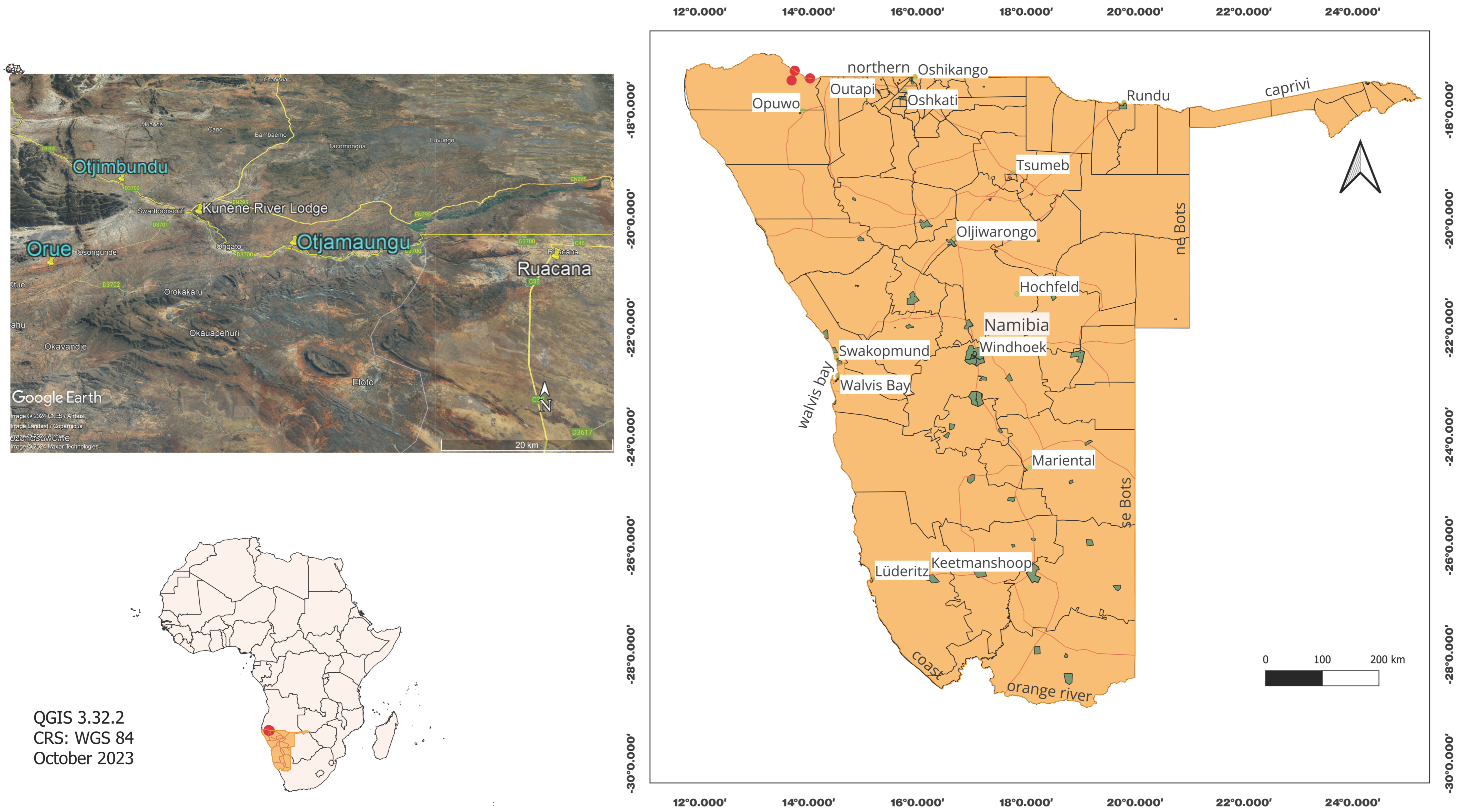
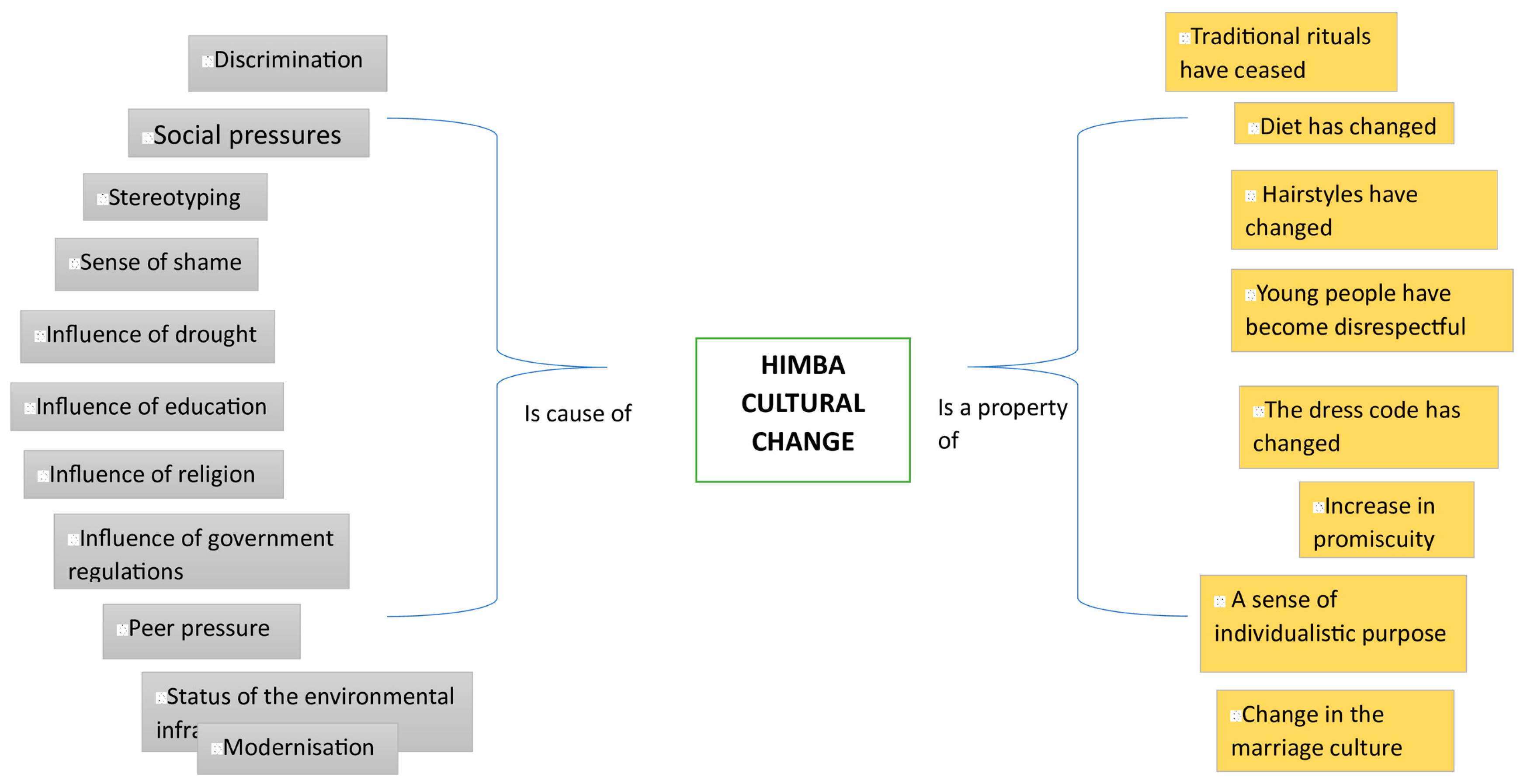
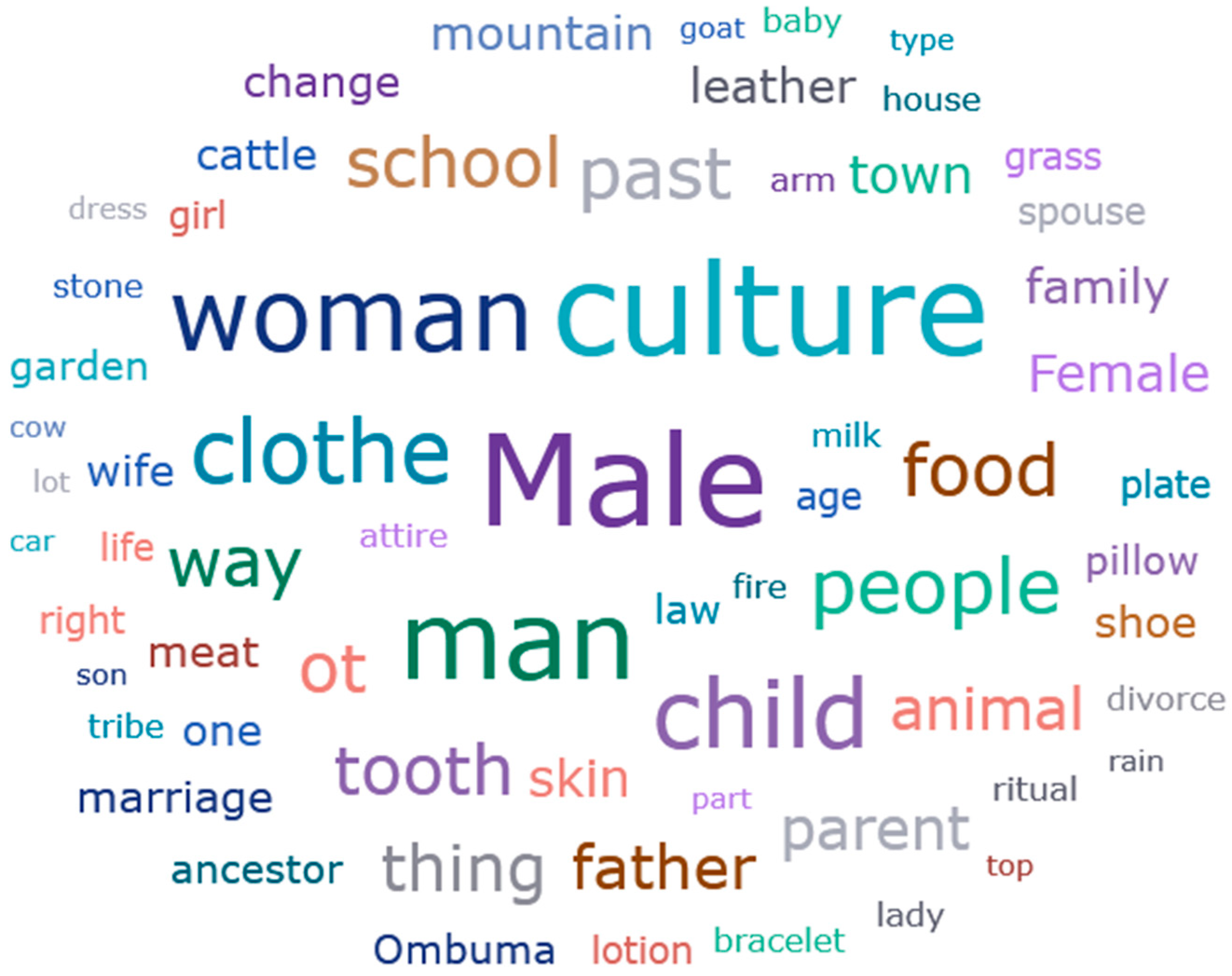
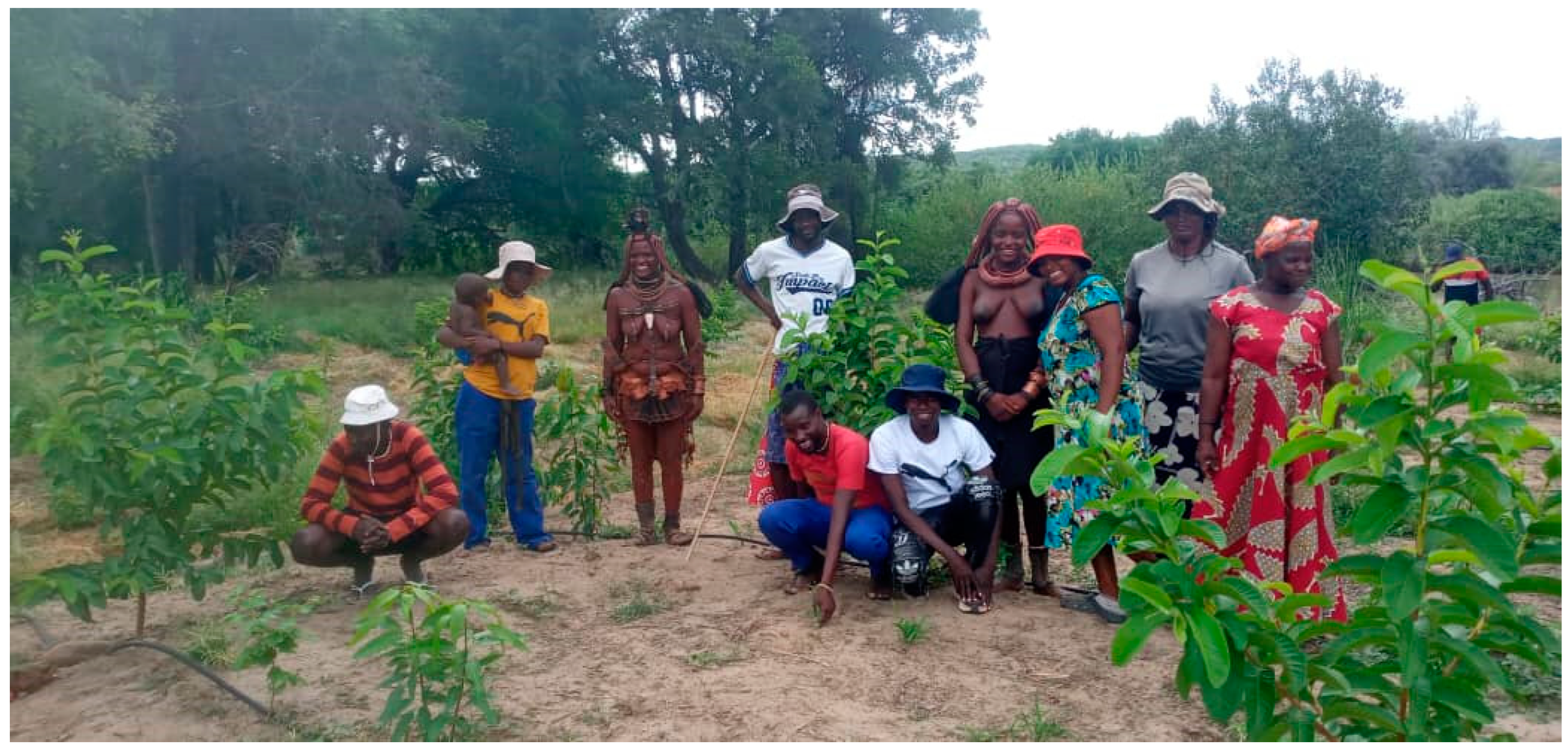
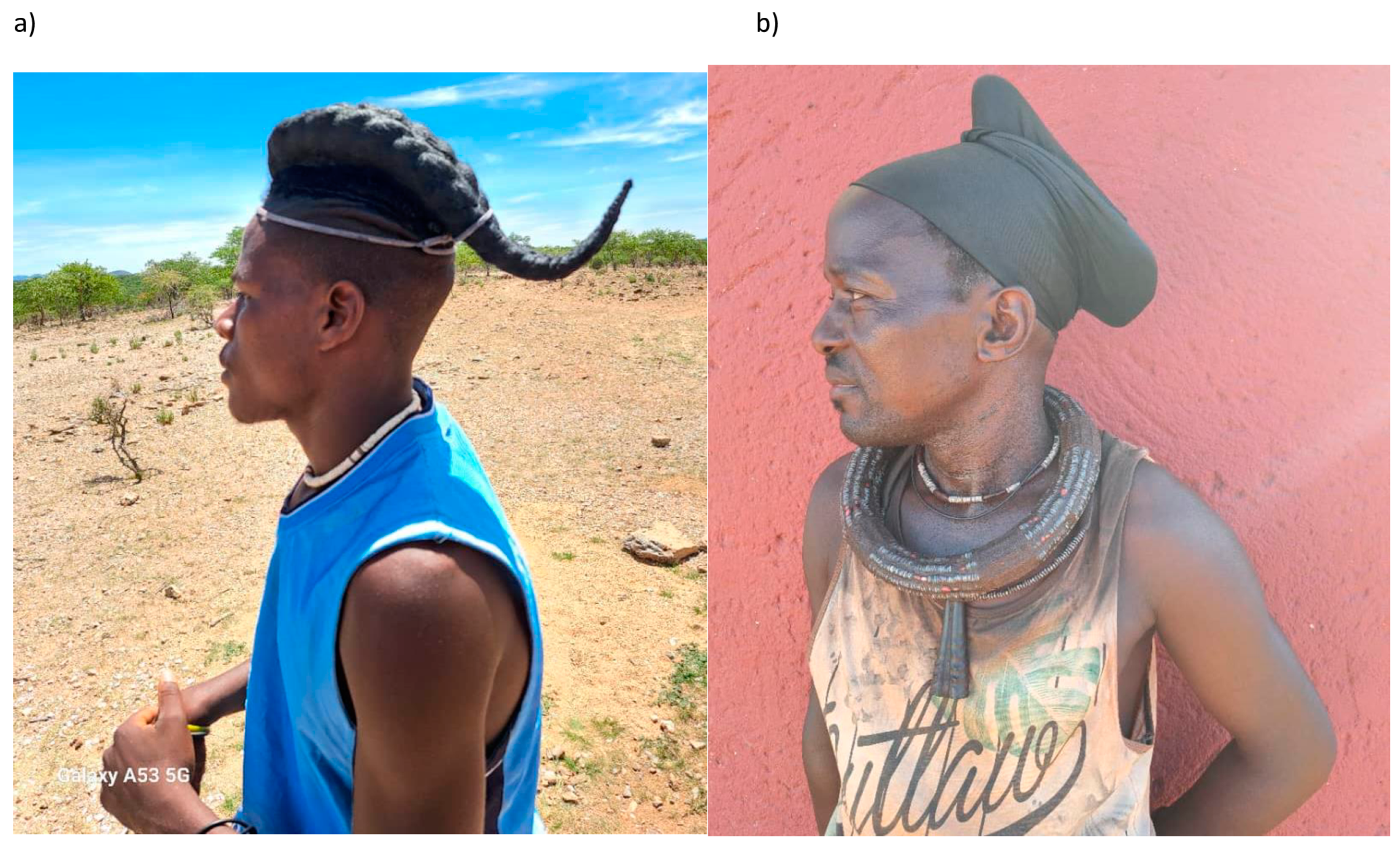
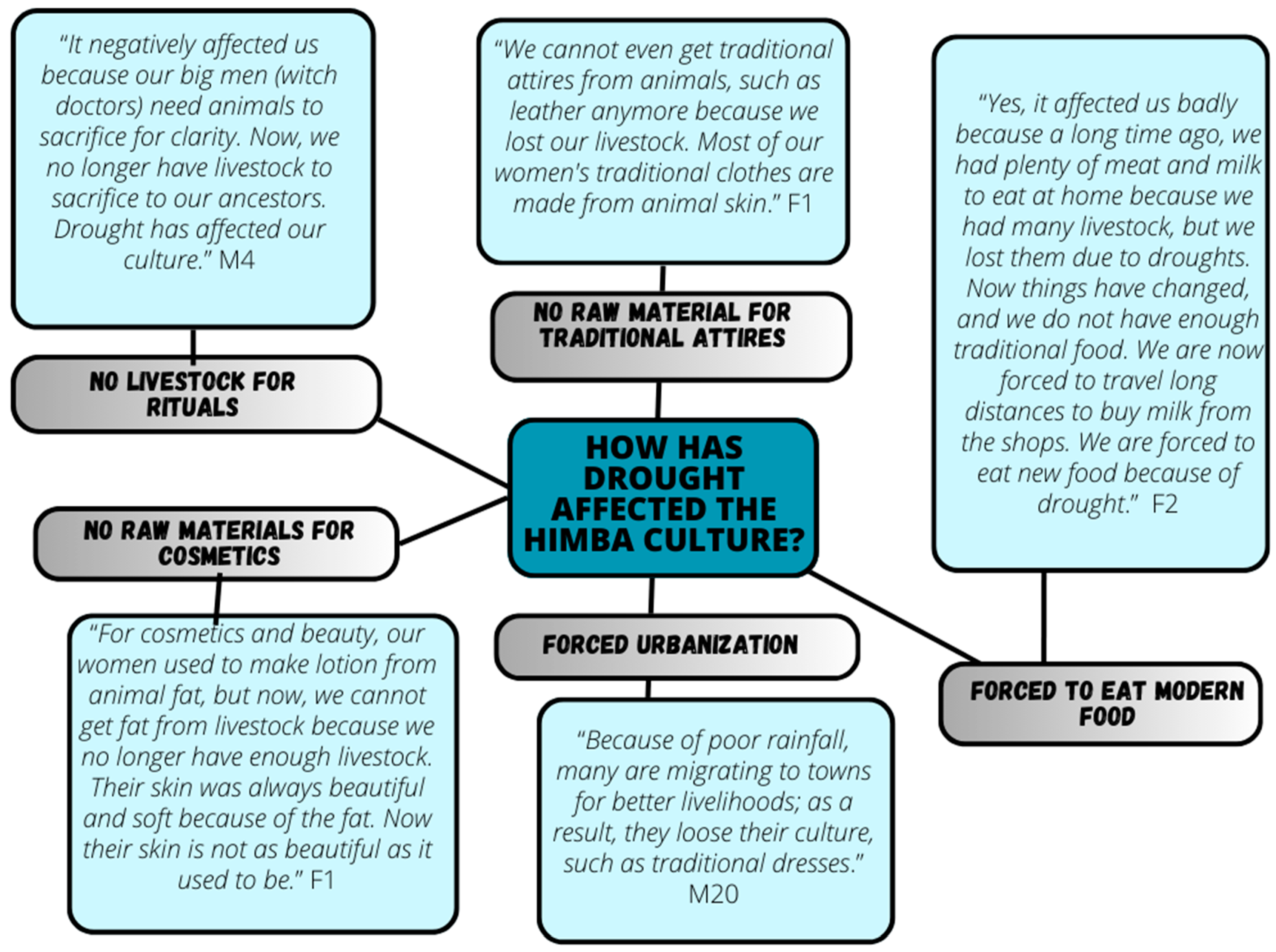
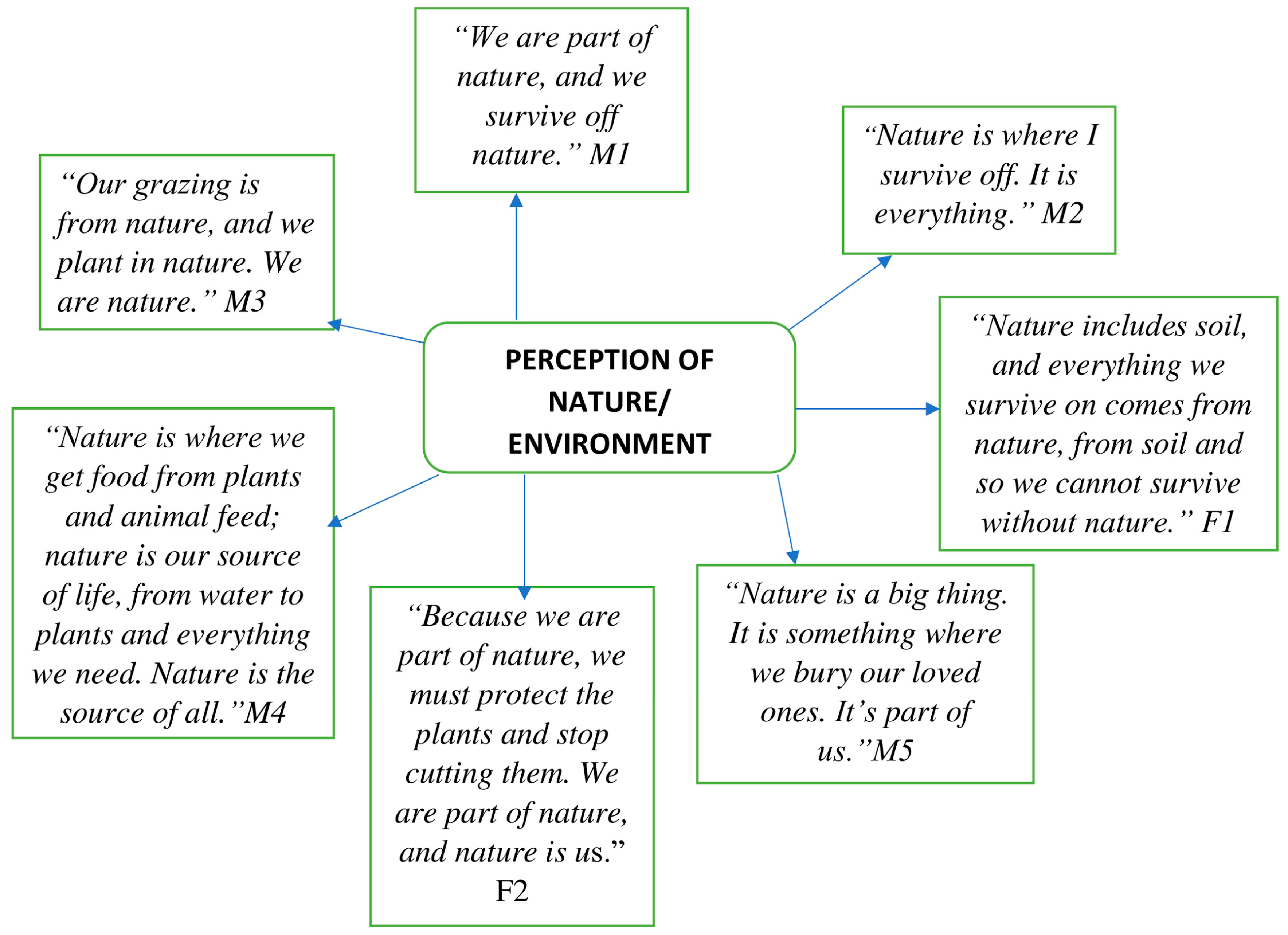
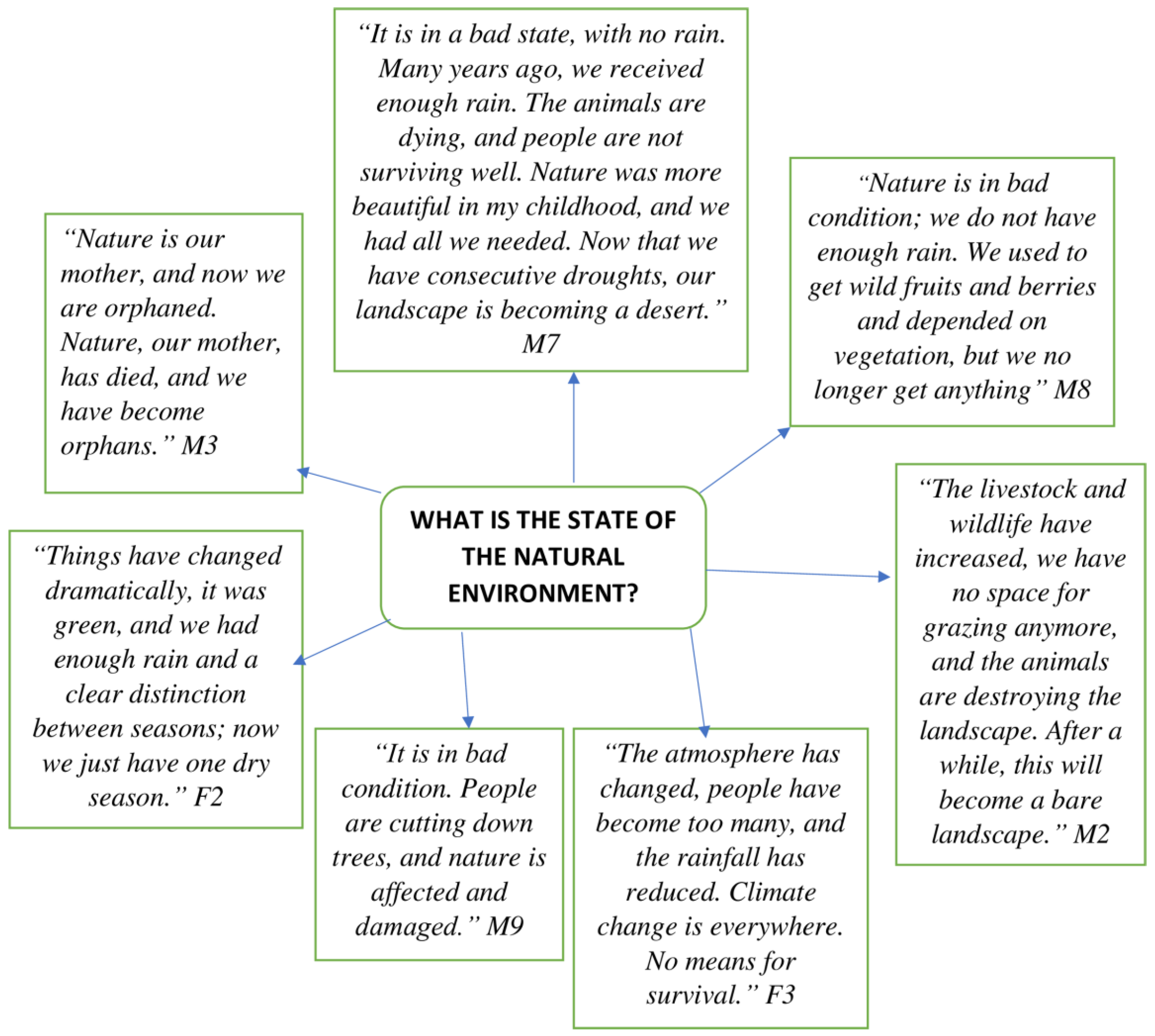
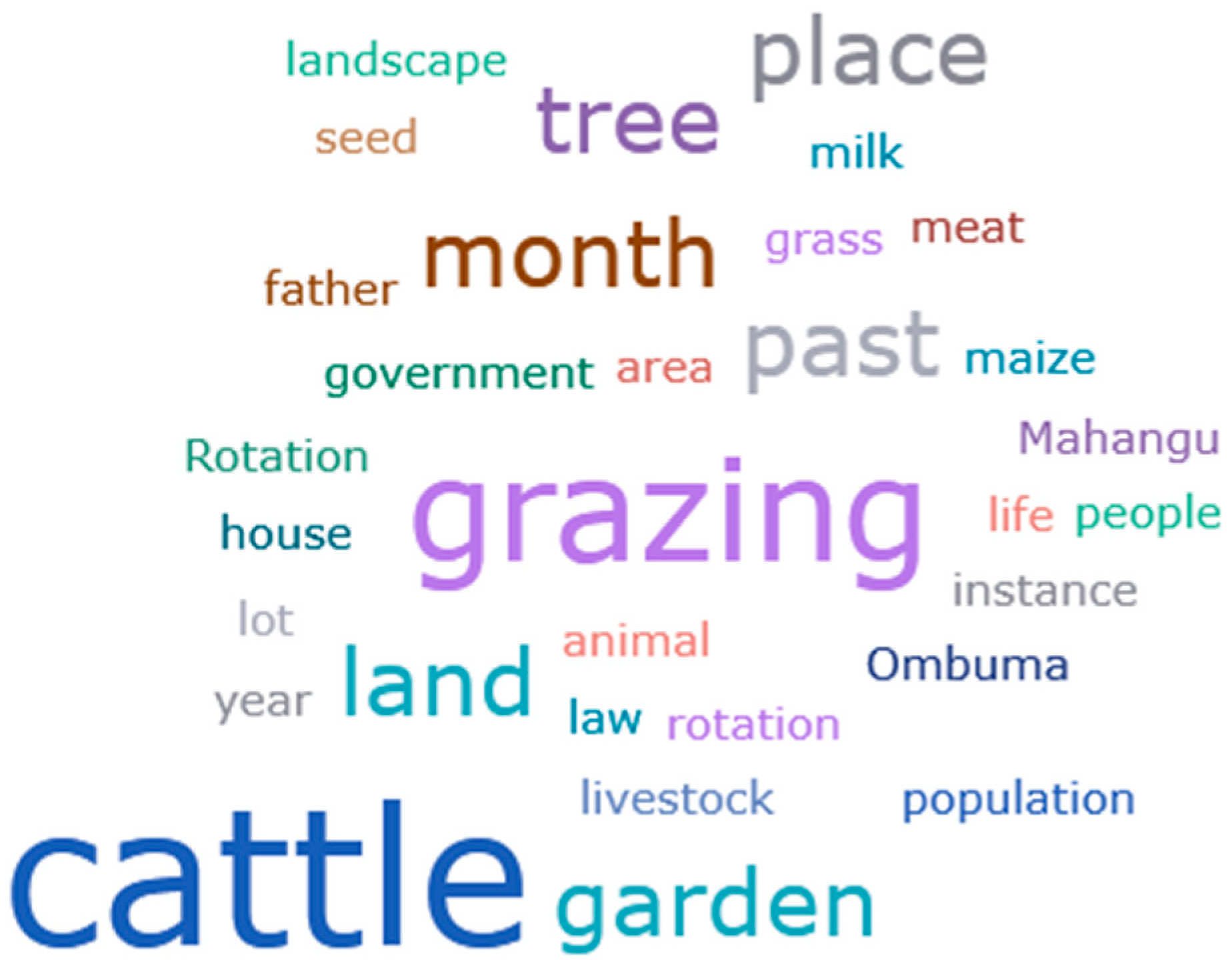
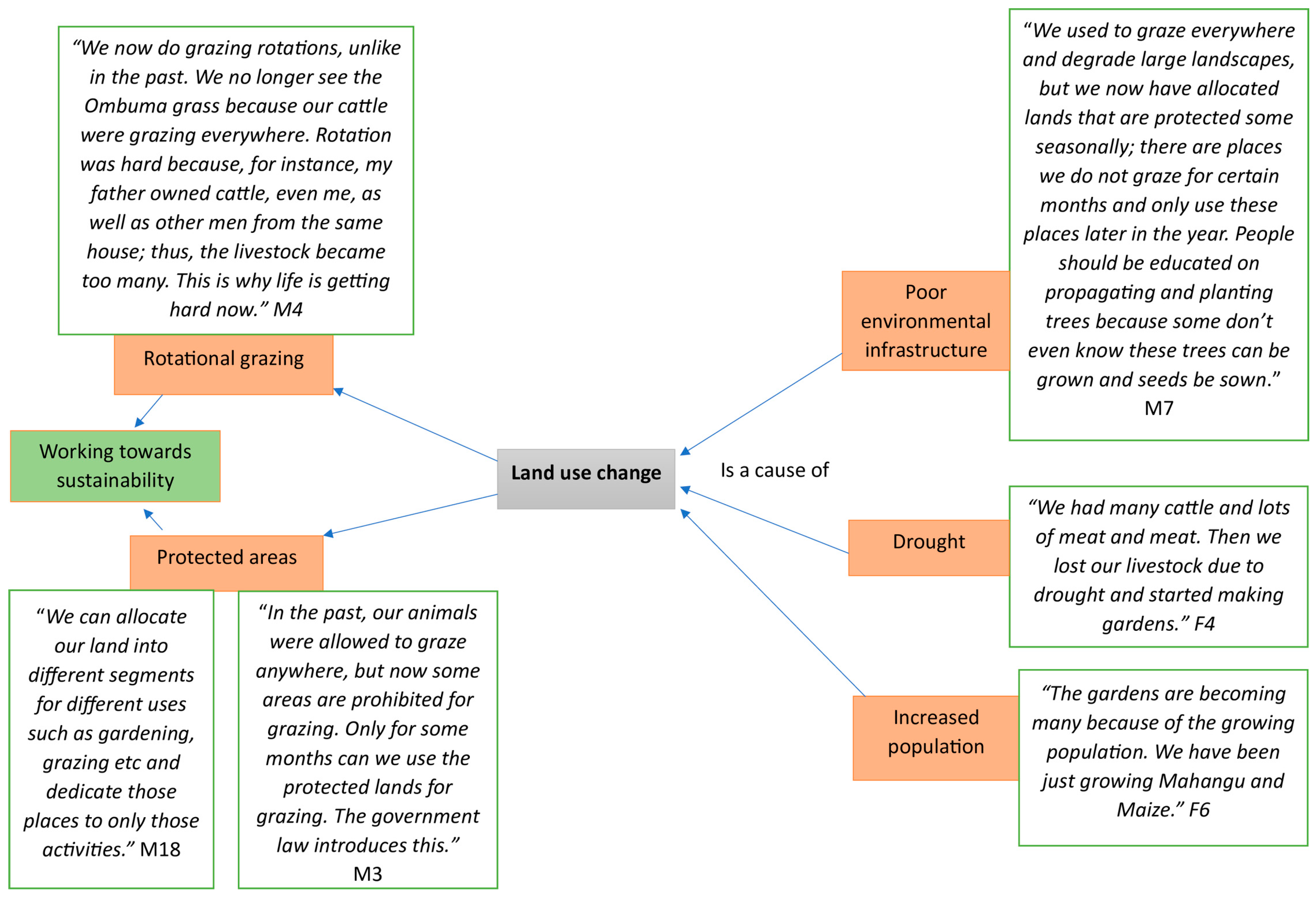
| Perceived Changes in the Himba Culture | |
|---|---|
| Negative | Positive |
| “We never used to add salt to our meat. When the people who went to school returned, they introduced us to salt, bringing us different diseases. We are getting sick because of the new food we are introduced to.” M5 | “Things are better now. I have good modern shoes that enable me to walk long distances, even to Opuwo. It was even a bit hard to make fire traditionally, but now we are using a matchstick. It made life easier, but some of the young ones have lost out on important skills.” M18 |
| “For me, the old practice was perfectly fine. It does not look good now. It was very different in the past; if a lady gets a baby while unmarried, that child will automatically belong to her father. If a man gets children with someone who is not their wife, then the children will not be regarded as his. They will belong to the woman’s father. That was much better compared to now. The burden is too much as young men are just dumping their many children to their mothers.” F3 | “The culture has changed from negative to positive because in the past we used stones as pillows, but now we are using modern soft pillows. Now it is good because the pillow is very soft. Even the cattle herders back then would use animal leather as blankets which got them sores, but at least now they are using modern matrasses.” M11 |
| “The change is a problem because only the people who went to school live better, but the uneducated suffer. This is because the jobs are only offered to those that are educated.” M5 | “Back then, we wore open leather shoes, which were very hard and did not protect the skin; now, we can wear boots and not get hard skin.” M12 |
| “Nowadays, young people choose their own spouses, and things have become chaotic now with so many divorces compared to how things were in the past.” M6 | “New developments are good because we used to walk very long distances, carrying all our belongings, but now there are cars. So, cars have made life easier.” M16 |
| “It is a good change because the way the new modern houses are built is very comfortable.” M8 | |
| Suggested Needs | Comments |
|---|---|
| Running water, toilets, and sewage | “We don’t have running or tap water, or toilets and sewage. We access the water from the river. We need these things.” M6 |
| Hospitals and clinics | “We have no clinic, not here in our village, no access to hospitals. All the nearby villages go to the available clinic in a village far from here. If you are pregnant, you have no access to services and people sometimes just die.” F3 |
| Better roads | “Many children are going to school, but the gravel roads are very bad, with no road grading and no network reception.” M21 |
| Cellphone coverage; electricity | “We do not have clean water and no cell phone coverage.” M13 |
| Job opportunities | “There are many problems here; we do not have jobs, and there is no capital to start a business.” M22 |
Disclaimer/Publisher’s Note: The statements, opinions and data contained in all publications are solely those of the individual author(s) and contributor(s) and not of MDPI and/or the editor(s). MDPI and/or the editor(s) disclaim responsibility for any injury to people or property resulting from any ideas, methods, instructions or products referred to in the content. |
© 2024 by the author. Licensee MDPI, Basel, Switzerland. This article is an open access article distributed under the terms and conditions of the Creative Commons Attribution (CC BY) license (https://creativecommons.org/licenses/by/4.0/).
Share and Cite
Inman, E.N. “There Are No True Himbas Anymore”: Exploring the Dynamics of the Himba Culture and Land Use in the Face of Change in Kunene Region, Namibia. Sustainability 2024, 16, 1582. https://doi.org/10.3390/su16041582
Inman EN. “There Are No True Himbas Anymore”: Exploring the Dynamics of the Himba Culture and Land Use in the Face of Change in Kunene Region, Namibia. Sustainability. 2024; 16(4):1582. https://doi.org/10.3390/su16041582
Chicago/Turabian StyleInman, Emilia N. 2024. "“There Are No True Himbas Anymore”: Exploring the Dynamics of the Himba Culture and Land Use in the Face of Change in Kunene Region, Namibia" Sustainability 16, no. 4: 1582. https://doi.org/10.3390/su16041582
APA StyleInman, E. N. (2024). “There Are No True Himbas Anymore”: Exploring the Dynamics of the Himba Culture and Land Use in the Face of Change in Kunene Region, Namibia. Sustainability, 16(4), 1582. https://doi.org/10.3390/su16041582








